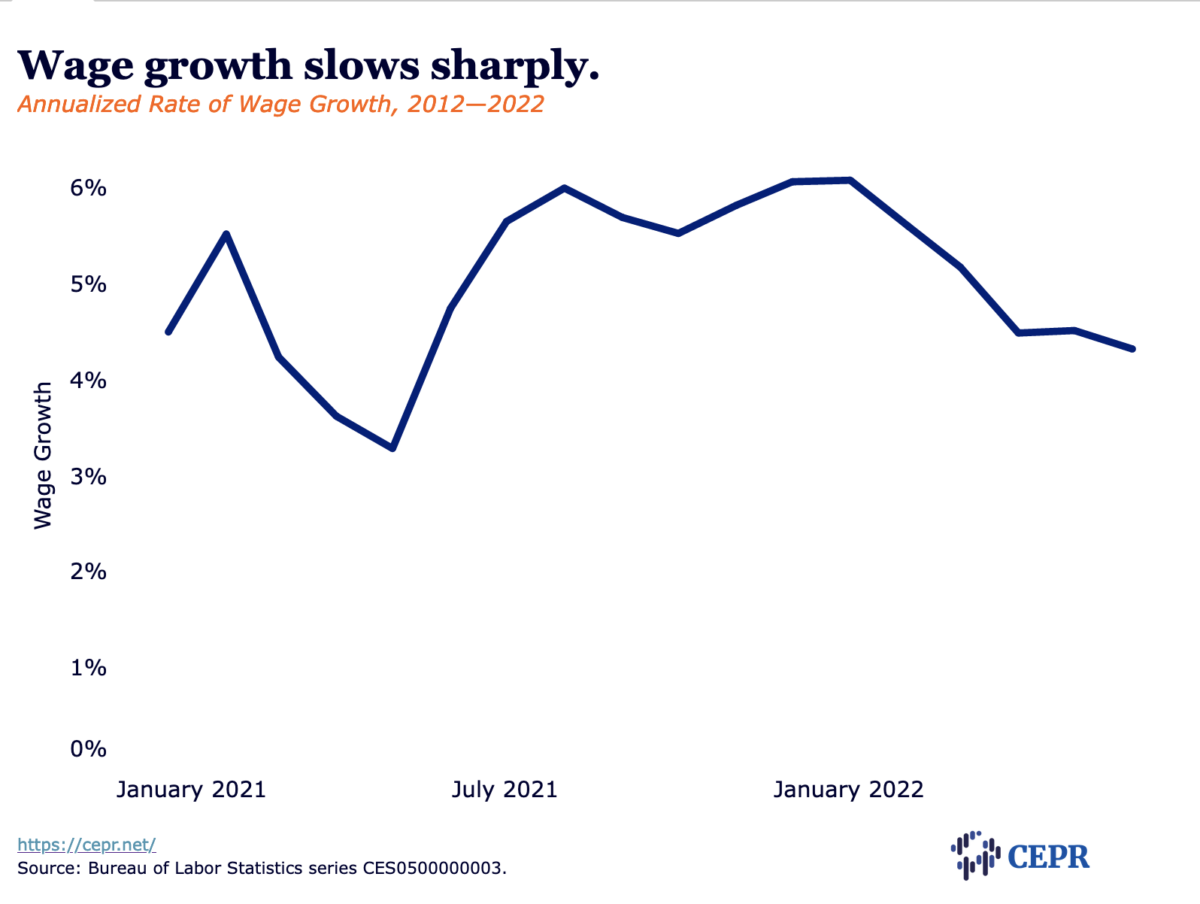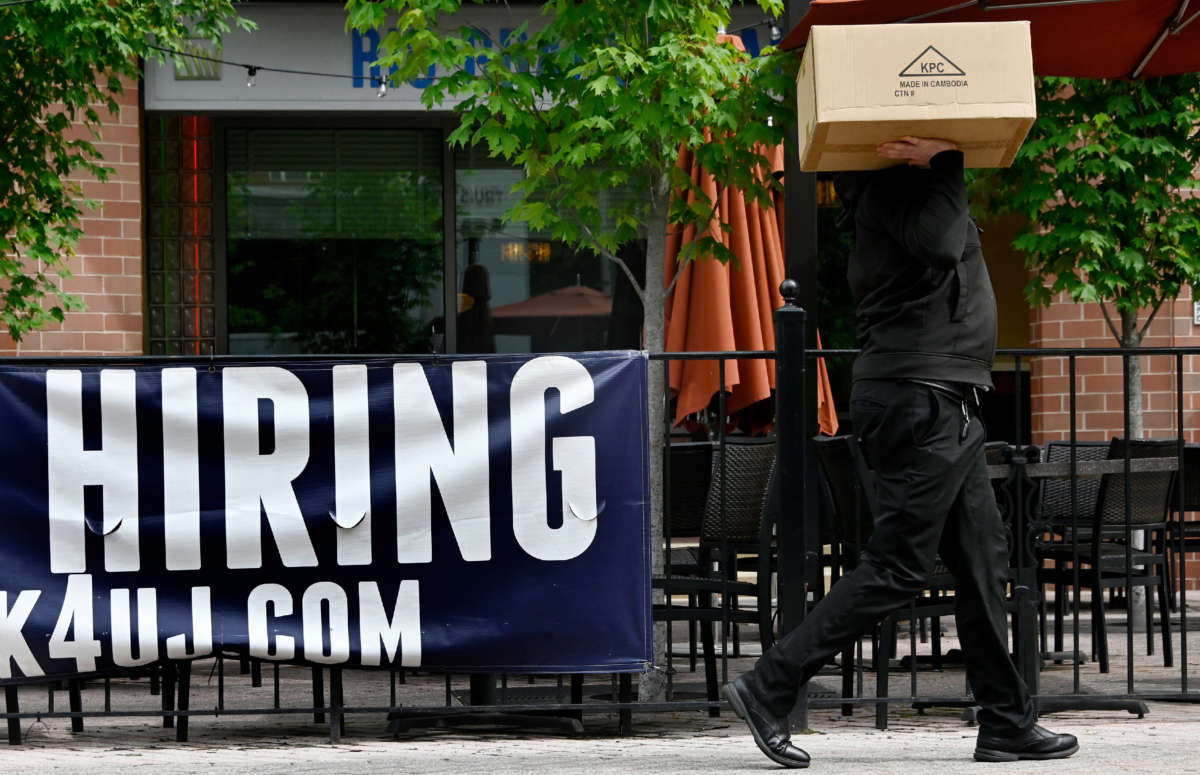The June employment report showed the economy created 372,000 jobs last month, with the private sector adding 381,000. Private sector employment is now 140,000 jobs above its pre-pandemic level. Total employment is still down 524,000, as local government employment is 599,000 below pre-pandemic levels, and state government employment is 57,000 below pre-pandemic levels. The unemployment rate was unchanged at 3.6 percent for the fourth consecutive month.
Wage Growth Moderates Further
Perhaps the best news in this report is further evidence of moderating wage growth. The annualized rate of wage growth, comparing the last three months (April, May, June) with the prior three months (January, February, March), was 4.3 percent. That is down from an annualized rate of 6.1 percent, comparing the winter (November, December, January) to the fall (August, September, October).
This is a huge deal because the Fed’s plans for aggressive rate hikes was based on a concern for a 1970s-type wage-price spiral. It is impossible to have a wage-price spiral when wage growth is slowing. As it is, the 4.3 percent annualized rate of wage growth is only a 0.9 percentage point higher than the 3.4 percent rate in 2019 when inflation was comfortably below the Fed’s 2.0 percent target.

Construction Again Adds Jobs, Manufacturing Employment Above Pre-Pandemic Levels
Construction added 13,000 jobs in June, with gains elsewhere offsetting a small decline in residential building. Overall employment in the sector is now 0.6 percent above pre-pandemic level. Lower housing starts will be a drag on employment in the sector, although this will be at least partially offset by easing supply chain problems, which is allowing for more completions. Manufacturing added 29,000 jobs, pushing employment in the sector slightly above its pre-pandemic level.
Air Transportation and Retail Add Jobs
Air transportation added 7,500 jobs in June. Employment in the sector is now 7.9 percent above the pre-pandemic level. The retail sector added 15,400 jobs, putting employment now 1.2 percent above the pre-pandemic level.
Healthy, But More Normal Job Growth in Hotels and Restaurants
Hotels added 14,800 jobs in June, while restaurants added 40,800 jobs. These are strong numbers but not out of line with what might be expected in a normal month with good job growth. These sectors were among the hardest hit by the pandemic.
Employment in hotels is still down 18.0 percent from its pre-pandemic level. Restaurant employment is 5.9 percent lower. It is likely that with a permanent decline in business travel, hotels will not recover their pre-pandemic employment levels. The same is likely the case with restaurants, where real sales are already well above pre-pandemic levels.
Nursing Homes and Child Care Centers Add Jobs, But Employment Still Far Below Pre-Pandemic Levels
Both nursing homes and childcare sectors have had difficulty adding jobs in the recovery as low pay and difficult working conditions make these jobs relatively unattractive. Nursing homes and childcare added 5,400 and 10,600 jobs in June, respectively. This leaves employment in the sectors 14.4 percent and 9.6 percent below pre-pandemic levels.
Local Government Adds 5,000 Workers, Employment Still Down 599,000 From Pre-Pandemic Level
Like nursing homes and childcare centers, state and local governments have had difficulty attracting workers in the recovery. Employment in local government is still down by 4.1 percent from pre-pandemic levels. More than half the drop is in local government education. State government employment is down by 57,000, or 1.1 percent from pre-pandemic levels.
U-6 Measure of Labor Market Slack Hits Record Low
While the unemployment rate was unchanged at 3.6 percent in June, a sharp drop in the number of people involuntarily working part-time lowered the U-6 measure of labor market slack to 6.7 percent, the lowest level on record.
Drop in Labor Force Participation Rates
The overall labor force participation rate (LFPR) fell by 0.1 percentage point to 62.2 percent. The LFPR for prime age (25 to 54) men dropped by 0.3 percentage point, while it fell 0.2 percentage point for prime age women. The June LFPR for men was 0.8 percentage point below its pre-pandemic peak, while it was 0.5 percentage point lower for women.
Length of Average Workweek Stable
The length of the average workweek was unchanged at 34.5 hours in June. For production and nonsupervisory workers, it was 34.0 hours, down from 34.3 hours last June. Employers that can’t find workers often increase workweeks. This does not seem to be a problem now.
Share of Unemployment Due to Voluntary Quits Rises, But Still Below Peaks
The percent of unemployment due to voluntary quits rose to 14.0 percent, still well below peaks of more than 15.0 percent hit in February of this year and peaks hit in 2000 and 2019. This is consistent with a strong, but healthy labor market.
Another Really Great Jobs Report
The June report showed considerably stronger job growth than was generally expected. It also showed a labor market that is looking more normal, although still very strong. We continue to see moderation in wage growth, which should alleviate concerns about a 1970s wage-price spiral. The unemployment rate remains near a 50-year low and the U-6 measure of labor market slack is the lowest on record. If the economy stays on this path, the second half of 2022 should look very good, as the supply chain issues get largely resolved and prices fall back to more normal levels in many areas.
Defying Trump’s right-wing agenda from Day One
Inauguration Day is coming up soon, and at Truthout, we plan to defy Trump’s right-wing agenda from Day One.
Looking to the first year of Trump’s presidency, we know that the most vulnerable among us will be harmed. Militarized policing in U.S. cities and at the borders will intensify. The climate crisis will deteriorate further. The erosion of free speech has already begun, and we anticipate more attacks on journalism.
It will be a terrifying four years to produce social justice-driven journalism. But we’re not falling to despair, because we know there are reasons to believe in our collective power.
The stories we publish at Truthout are part of the antidote to creeping authoritarianism. And this year, we promise we will kick into an even higher gear to give you truthful news that cuts against the disinformation, vitriol, hate and violence. We promise to publish analyses that will serve the needs of the movements we all rely on to survive the next four years, and even build for the future. We promise to be responsive, to recognize you as members of our community with a vital stake and voice in this work.
Please show your support for Truthout with a tax-deductible donation (either once today or on a monthly basis).
